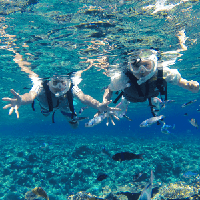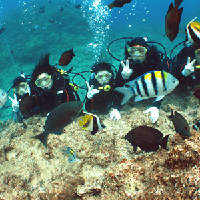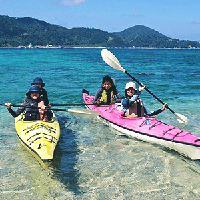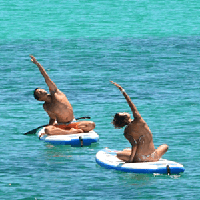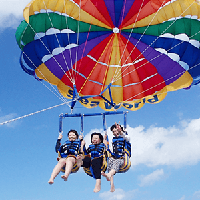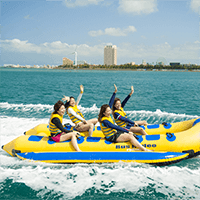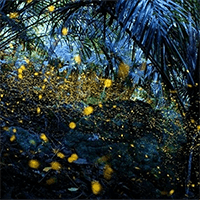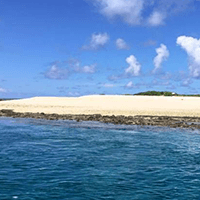List of Izu
- Age 1~Age 70
- Over 6 hours on the day
- 08:40 / 09:50
Get on and off at the meeting point08:40▼Nihonbashi Station Exit 2 (Namba-Shinsaibashi area)09:50▼Kyoto Station Hachijo Exit (in front of 7-Eleven)10:30▼Kinkaku-ji Temple (approx. 40 mins)Visiting fees are at the customer's expense.12:00▼Kiyomizu-dera Temple area (individual visit, free stroll, lunch on your own / approx. 3.5 hours)15:30▼Fushimi Inari Taisha Shrine (approx. 70 mins)17:00▼After enjoying the day's itinerary, start heading back.19:00▼Shinsaibashi, Dotonbori area (free stroll / approx. 1 hour)This is a shared tour, and participants come from all over the world.
- Age 1~Age 70
- Over 6 hours on the day
- 07:30
07:30-08:30: Pick-up/drop-off/transfer to hotel/private inn Hotels/private inns within the Osaka Loop Line 10:00 ▼ Kiyomizu-dera area (individual worship, free stroll, free lunch/approximately 3 hours) Recommended sightseeing course Course 1: Kiyomizu-dera (customer pays admission fee) - Ni-san-nen-zaka - Ishibe-koji - Gion·Hanami-koji-dori - Yasaka Shrine You can visit your favorite spots according to your stamina and time~Course 2: Kimono experience (Customers who are interested can wear a kimono and enjoy the old townscape and touring Kiyomizu-dera Temple. Let's take pictures of the wonderful moment.) (There are many kimono shops near Kiyomizu-dera Temple and Fushimi Inari Taisha Shrine. We recommend renting a kimono at a shop at Kiyomizu-dera Temple and returning it at a shop at Fushimi Inari Taisha Shrine. The fee is at the customer's expense.) 13:30 ▼ Fushimi Inari Taisha Shrine (individual visit and free stroll / about 70 minutes) 16:00 ▼ Nara Park (individual visit and free stroll / about 1.5 hours) "Deer and autumn leaves" interweave "Nara Park" The contrast between the autumn leaves and evergreen trees is vivid Recommended tourist spot [Todaiji Temple] (Admission fee is at the customer's expense.) Todaiji Temple was built during the Nara period. Nara is popular with tourists and once served as the capital of Japan. It is registered as a World Heritage Site as one of the "Cultural Monuments of Ancient Nara" by UNESCO. Todaiji Temple has eight national treasure buildings, 14 buildings with 24 national treasure Buddha statues, and nine other national treasures, including paintings and books. The famous Great Buddha, the Great South Gate, the Kongorikishi statues, and the Hokkedo Hall, as well as the Buddha statues enshrined within, are all national treasures. There are very few places in Japan where you can see so many national treasures at once. Admission fees: Todaiji Temple Great Buddha Hall: 600 yen for adults (junior high school students and above), 300 yen for elementary school students; Great Buddha Hall and Todaiji Museum: 1000 yen for adults (junior high school students and above), 400 yen for elementary school students 17:30▼After a fun day of sightseeing, we start to head back. 18:30Shinsaibashi, Dotonbori area (Guests on the course that takes you to your hotel or guesthouse should wait for the shuttle bus. When the shuttle bus arrives, we will take you back to your hotel or guesthouse and the tour will end.)This is a mixed tour, and participants come from all over the world.
- Age 1~Age 70
- Over 6 hours on the day
- 08:40 / 09:50
Boarding and disembarking at the meeting point 08:40▼Nihonbashi Station Exit 2 (Namba-Shinsaibashi area) 09:50▼Kyoto Station Hachijo Exit (in front of 7-Eleven) 10:00▼Kiyomizu-dera area (individuals must visit the temple, stroll around freely, and have lunch at their leisure / approx. 3 hours) Recommended sightseeing course Course 1: Kiyomizu-dera Temple (customers are responsible for admission fees) - Ni-Sannenzaka - Ishibekoji - Gion·Hanamikoji-dori - Yasaka Shrine You can visit your favorite spots according to your stamina and time~Course 2: Kimono experience (Customers who are interested can wear a kimono and enjoy the old townscape and touring Kiyomizu-dera Temple. Let's take pictures of the wonderful moment.) (There are many kimono shops near Kiyomizu-dera Temple and Fushimi Inari Taisha Shrine. We recommend renting a kimono at a shop at Kiyomizu-dera Temple and returning it at a shop at Fushimi Inari Taisha Shrine. The fee is at the customer's expense.) 13:30 ▼ Fushimi Inari Taisha Shrine (individual visit and free stroll / about 70 minutes) 16:00 ▼ Nara Park (individual visit and free stroll / about 1.5 hours) "Deer and autumn leaves" interweave "Nara Park" The contrast between the autumn leaves and evergreen trees is vivid Recommended tourist spot [Todaiji Temple] (Admission fee is at the customer's expense.) Todaiji Temple was built during the Nara period. Nara is popular with tourists and once served as the capital of Japan. It is registered as a World Heritage Site as one of the "Cultural Monuments of Ancient Nara" by UNESCO. Todaiji Temple has eight national treasure buildings, 14 buildings with 24 national treasure Buddha statues, and nine other national treasures including paintings and books. The famous Great Buddha, the Great South Gate, the Kongorikishi statues, and the Hokkedo Hall, as well as the Buddha statues enshrined within, are all national treasures. There are very few places in Japan where you can see so many national treasures at once. Admission fee: Todaiji Temple Great Buddha Hall: 600 yen for adults (junior high school students and above), 300 yen for elementary school students; Great Buddha Hall and Todaiji Museum: 1000 yen for adults (junior high school students and above), 400 yen for elementary school students 17:30▼After a fun day of sightseeing, we start heading back. 18:30Shinsaibashi, Dotonbori area (free time/about 1 hour)This is a mixed tour, and participants come from all over the world.
- Age 20~Age 99
- 2~3 hours /3~4 hours
- 13:00
Blessed with an abundance of underground water veins that spring up from the Momoyama Hills, Fushimi was once called "Fushimizu" (literally "fushimizu" in Japanese), and it is said that full-scale brewing began here about 400 years ago because the water was suitable for sake brewing. It flourished as a castle town and a port on the Yodo River on the Tokaido, and sake breweries with white walls stand out along the Uji River and canals. The streets of Fushimi, where you can enjoy the atmosphere of a sake brewing town, with ten-koku boats sailing among swaying willows, have been designated as the "Fushimi Minamihama Neighborhood Landscape Development District" by Kyoto City. ~Time Schedule~13:00 [Meet at the north ticket gate of Keihan Electric Railway Nakashojima Station] Meet in front of the sake barrel object located immediately after exiting the north ticket gate! This is where the tour begins! It's a flat road, but you'll be walking about 2 kilometers, so please wear comfortable shoes on the day. 13:15 [Gekkeikan Okura Sake Museum] ☆Three types of sake tastings, including Daiginjo, and a special Gekkeikan sake cup included☆The building is a wooden storehouse built in the Meiji era that is still in use. You can drink the underground water used in sake brewing from the well in the courtyard. Just like Fushimi sake, it is very soft and delicious, so please try it. You will be surprised at how soft it is. In the exhibition room, you can see traditional sake brewing tools, which are designated as tangible folk cultural properties of Kyoto City. 13:50 [Fushimi Yume Hyakushu] ☆Winter limited sake ice cream included☆Shop & cafe "Fushimi Yume Hyakushu". In fact, this building is the former main store of Gekkeikan, built in the Taisho era. In addition to Gekkeikan, various Kyoto sakes and souvenirs are sold in the store. We have prepared a 3-type sake tasting set including appetizers here. 14:30 [Kizakura Kappa Country] ☆Kyoto's oldest local beer included☆ Kiizakura is famous for its sake commercials using kappa characters, but it is also the first company to make local beer in Kyoto. Therefore, in addition to the sake manufacturing process, Fushimizugura is characterized by the fact that you can tour the beer factory. After the tour, try tasting sake and beer in the lovely courtyard. 15:15 [Aburacho] ☆Authentic sake tasting set of three types☆ We have more than 80 types of sake from all 18 breweries in Fushimi, mainly ginjo sake and daiginjo sake, and more than 100 types including seasonal limited edition sake. In addition, at the sake tasting counter attached to the store, you can compare three types in small cup size as well as a glass. Just looking at the bottles will make you feel happy.
- Age 13~Age 80
- Over 6 hours on the day
- 08:50
Welcome to KYOTO, Japan!Let's dive into and discover Kyoto's kaleidoscope of sights and sounds.Explore as many as 12 attractions in the city on this full day tour.We take you to the must-see sights and also show you the hidden gems of each location.Let's stroll the city on foot and by metro like a local for the day.Transportation and the street in the area are very complicated, even for the Japanese.However, all guide ours were born and raised in Japan, have lived for a long time close to the area, and are well-trained expert locals.So, we can take you to so many places, at the best time, within a limited timeframe.We recommend you join our tour on your first day in Tokyo. Because, you can learn not only about sights, but also about Japanese history, culture, society, ways of thinking, values and even about local etiquette, how to take public transportations, our everyday life.But above all, the best part of traveling is good food.JR Saga-Arashiyama station at 8:50Arashiyama, Randen Tram Line, Ryoan-ji Temple, Sushi-go-round(lunch, Ramen, Kara-Age, Beer), Kinkakuji Temple, Fushimi Inari Shrine, Kiyomizu-zaka slope, Kiyomizu Temple, Sanneizaka, Yasaka Pagoda, Gion area, Gion shopping street
- Age 6~Age 99
- 1~2 hours
- 13:00
When most people think of Takarazuka, they think of the Takarazuka Revue, but surprisingly, there are not only operas, but also hot springs, memorial halls, and other attractions around Takarazuka Station. After the performance in Takarazuka, why don't you take a walk around the city from a different side with a tour guide? There will surely be new discoveries! ~Time schedule~ 13:00 [Meet in front of the Hankyu Takarazuka station ticket gate] The tour starts here! Although the road is flat, you will walk about 2 kilometers, so please wear comfortable shoes on the day. 13:10 [Birthplace of Carbonated Rice Crackers and Wilkinson Vending Machine] The popular carbonated water "Wilkinson Tansan" when drinking a highball. Did you know that this "Wilkinson Tansan" originated in Takarazuka? In front of Takarazuka Onsen, there is an all-Wilkinson vending machine only here in Japan. 13:20 [Takarazuka Onsen Hotel Wakamizu] During the Showa era, Takarazuka Family Land and hot springs were located along the Muko River, and it was a prosperous resort. There are only a few hotels in operation now, but the atmosphere of the hot spring town of yesteryear still lingers in the air. 13:40 [Takarazuka Ohashi] After passing Takarazuka Onsen, a large tower apartment is currently under construction on the site where the "Takarazuka Hotel", which was founded in 1923, used to be. Please take a look at the town of Takarazuka, which has been renewed with the changing times. The view from Takarazuka Bridge is a great photo spot. The set of Takarazuka Opera, Hankyu Railway and Mukogawa can only be seen here. The sidewalk of Ohashi is also spacious, so you can take pictures slowly. (Every 30 minutes on the hour, the fountain "Big Phoenix" rises from the Muko River, so if you're lucky, you can see it.) 13:55 [Tezuka Osamu Memorial Museum] Did you know that Mr. Osamu Tezuka was actually from Takarazuka? Uka Born in Toyonaka City, Osaka Prefecture in 1928, I lived in Takarazuka City, Hyogo Prefecture from the age of 5, when I was just starting to understand things, to my sensitive boyhood, and until I was about to enter adulthood when I was 24. A museum has been built in Takarazuka to commemorate his achievements, not only as a city where he once lived, but also as a city that gave the underlying theme of all Tezuka manga. 14:40 [Hana no Michi] I think it goes without saying for Takarazuka fans, but it seems that Hana no Michi also means a flower path to the Takarazuka Grand Theater. It is truly a “flower path to the world of dreams”. There are bronze statues of opera performances such as "The Rose of Versailles" and a bronze statue of "Ichizo Kobayashi", the founder of Hankyu Corporation and the Takarazuka Revue. 14:50 [Takarazuka Hotel] There is a newly relocated Takarazuka Hotel in the middle of Hananomichi. In 2009, the Takarazuka Hotel was selected as the official hotel of the Takarazuka Grand Theater with the concept of "continuing your dreams here." Please take a look at the dignified appearance. 15:00 [Arrival at Takarazuka Station]
- Age 20~Age 99
- 3~4 hours
- 13:00
A visit to a sake brewery is a must on any trip to the Kansai region of Japan. Nada Ward in Kobe City is the place with the largest production of sake in Japan, and there are about 30 sake breweries in the area called "Nada Gogo", which stretches 24km from east to west. The history of sake brewing dates back to around 1330. Speaking of "Nada's sake", it is so famous that it appears in classic rakugo, and Nada is blessed with various conditions suitable for sake brewing. Mineral-rich hard water called "Miyamizu", the production area of "Yamada Nishiki", which is famous as "the king of sake rice", and "Rokko Oroshi" blowing down from Mt. Rokko bring a cold and optimal climate. This tour will take you to 3 carefully selected locations and sample over 25 different types of sake. A guide who is familiar with sake and the Nada area will guide you to the profound world of sake. ~ Flow of the day ~ 13:00 Meet in front of the ticket gate of Ishiyagawa Station (Hanshin Line) 13:30 1st place Sake brewery With a history of over 250 years, it is the smallest sake brewery in Nada Ward, and the production volume is 1.8 bottles ( 1.8L) It is a small scale of about 40,000 bottles. Although the scale is small, there are well-known high-quality brands that are known all over Japan. You will be able to taste mainly unpasteurized sake (liquor with live yeast) that can only be enjoyed in Japan. This yuzu sake is the best! *We are not open on Saturdays and Sundays, so we will take you to another sake brewery. note that. 14:00 2nd place Sake brewery Founded in 1751, the president is the 13th generation brewery. There are a wide variety of authentic sake, including "Junmai Ginjo", which has been served at the Nobel Prize banquet five times in the past. The souvenir corner has a wide variety of snacks, sake bottles, masu, and more. Tasting with an explanation from the brewer is always very popular with tourists! 15:00 3rd Place Sake Brewery This is the biggest sake brewery in Japan. There is a museum that exhibits the traditional construction methods. Wear a happi coat and take a memorable photo at a commemorative photo spot. 15:30 4th place In Sakagura Nada Ward, it's a small sake brewery, but a sake master with over 60 years of experience will serve you sake. While making traditional, high-quality sake, it is also innovative and rich in variety. For example, there are whiskeys that have been aged in American oak for 14 years, sherry that has been aged in brandy barrels for 14 years, and sake that is a blend of white wine Chardonnay and sake. The image of Japanese sake will be overturned. This is optional, and there is a paid tasting counter. You can enjoy a small plate of cheese made from dairy cows raised on Mt. Rokko and the finest Shizukuzake. 16:30 Leave Uozaki Station (Hanshin Line)
最近チェックしたプラン
Please wait a moment
![[Day trip | Pick-up from city hotels] Ancient Kyoto Japanese-style tour: Kinkaku-ji Temple - Kiyomizu-dera Temple - Fushimi Inari Taisha Shrineの画像](https://img.activityjapan.com/10/55487/10000005548701_P3BiVCAd_3.jpg?version=1733822342)
![[13-person team/Pick-up from city hotels] Kyoto, Nara, Kiyomizu-dera Temple, Kimono experience, Yasaka Shrine, Fushimi Inari Taisha Shrine, Nara Parkの画像](https://img.activityjapan.com/10/55578/10000005557801_P3BiVCAd_3.jpg?version=1722496202)
![[Day Trip] Kyoto, Nara, Kiyomizu-dera Temple, Kimono Experience, Yasaka Shrine, Fushimi Inari Taisha Shrine, Nara Park, Todaiji Temple Day Trip (Departing from Osaka/Kyoto)の画像](https://img.activityjapan.com/10/55460/10000005546001_P3BiVCAd_3.jpg?version=1730786226)

![[Kyoto] Complete Kyoto Tour in One Day, Explore All 12 Popular Sights!の画像](https://img.activityjapan.com/10/52322/10000005232201_z8QiQozH_3.jpg?version=1703416682)
![[Hyogo/Takarazuka] A 2-hour walking tour to discover new things in Takarazuka! Also introduced in Bra Tamori! Parents and children and one person are also welcome *Guide includedの画像](https://img.activityjapan.com/10/44053/10000004405301_5u86vXcx_3.png?version=1681196347)

